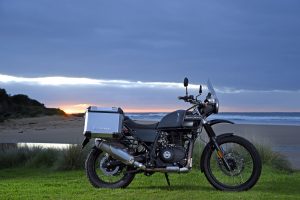
I learned several things on the recent Australian press launch of Royal Enfield’s Himalayan.
The first of which is I have been pronouncing ‘Himalayan’ incorrectly my entire life.
It is pronounced ‘h’mahl-yun’, rather than ‘him-a-layuhn’. So there’s that.
But there were other things. Not the least of which was an insight into the mindset of a company that sells more than 600,000 motorcycles a year, and which styles itself as one of the oldest motorcycle manufacturers on earth, having started production in 1901.
A brief history lesson is order. Because to know where you are, means knowing where you came from. But Royal Enfield’s is a convoluted history, which begins in 1851, when George Townsend decided he was going to make sewing needles in Redditch, England.
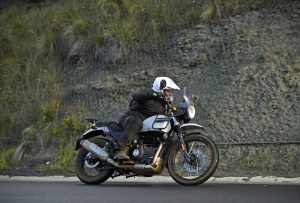
His son, George Junior, started making pushbike parts for cycle manufacturers in 1882, and by 1886 complete bikes were being churned out under the names ‘Townsend’ and ‘Ecossais’. And they went broke in 1891.
The pieces were picked up by various interests including BSA and later Norton Villiers, and the resultant Enfield Cycle Company produced the Royal Enfield Bullet in 1901, which remains the longest-lived motorcycle design in history.
In Royal Enfield’s case, the ‘Royal’ warrant was appended as a result of its involvement in the manufacture of guns for the British, and which prompted it to declare its motorcycles were “Built Like a Gun”, implying reliability and ruggedness.
This all limped along until the 50s, whereupon the western world decided it no longer had much use for quaint English motorcycles, and the curtain began to come down on the Poms.
Ever resourceful, the Enfield Cycle Company partnered itself up with Madras Motors in India (where Royal Enfields had been sold since 1949), and formed Enfield of India – and promptly began assembling the 350cc Bullets from parts imported from England. The chuggy little 350 had found a new home among the teeming and impoverished masses of India, and by 1957, Enfield of India began acquiring the machinery necessary to make the bikes itself, which it finally accomplished by 1962.
Its relative success in that market was linked to a massive Indian government order for 800 bikes that were to be used for patrolling the country’s borders.
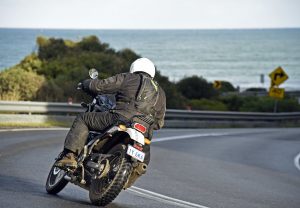 And so Royal Enfield production went on in India, oblivious to the massive technological leaps being made in the motorcycling worlds of Germany, Japan and the USA. It seems there wasn’t much call for such technological advances when one is patrolling the dirt roads of Uttar Pradesh and being shot at by tribesmen for scaring their goats. One can understand how little use the Indians would have for big-capacity heavy Harleys, or the emerging hate-filled two-strokes set to dominate racing in the ensuing decades. It made good sense to have a motorcycle that would run on bad kerosene and could be repaired using rocks and prayers to Ganesh.
And so Royal Enfield production went on in India, oblivious to the massive technological leaps being made in the motorcycling worlds of Germany, Japan and the USA. It seems there wasn’t much call for such technological advances when one is patrolling the dirt roads of Uttar Pradesh and being shot at by tribesmen for scaring their goats. One can understand how little use the Indians would have for big-capacity heavy Harleys, or the emerging hate-filled two-strokes set to dominate racing in the ensuing decades. It made good sense to have a motorcycle that would run on bad kerosene and could be repaired using rocks and prayers to Ganesh.
So Enfield of India kept on keeping on until 1999, when it changed its branding to Royal Enfield. This change caused the owner of the brand, one Matt Holder of Aerco Jiggs and Tools who had purchased the rights when the English concern went belly-up in 1967, to sue the Indian company. But an English court found in favour of the sub-continent, and as it subsequently turned out, Royal Enfield of India embraced this victory, went from strength to strength, and now exports its motorcycles all over the world.
Still, in rich western countries, the bikes are often looked at askance by riders. Sure, they’re cheap, but the Indian market’s criteria for purchasing a motorcycle (great fuel economy and a low seat-height), don’t really apply to customers who crave upside-down forks, five engine maps, voodoo-like traction control and a thirst for high-octane fuel.
So Royal Enfield occupies a strange kind of segment in the fabulously rich part of the world.
They still look kinda old-fashioned and funky, so they appeal greatly to pensioners and the bearded hipster she-males, who don’t do a lot of riding, and who certainly aren’t interested in carving corners, or conquering the boulders of Erzberg. And because Indian manufacturing doesn’t approach the hermetically sealed production surgeries of Austria, Germany and Japan, Royal Enfields have remained a kind of quaint and often mechanically troubled novelty purchase for the people who buy them.
Now it’s possible you’ve read statements about Royal Enfields “bouncing their way across the top of the Himalayan mountains”, or how the Himalayan will “take you almost anywhere you want to go for as long as you want to go there”, and how it is “the best Royal Enfield ever built”.
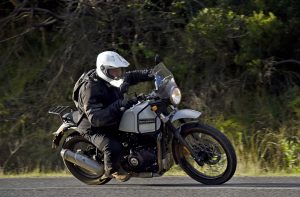
Now, while it is entirely possible the Himalayan is the “best Royal Enfield ever built”, given it is the only one I have ever ridden, I am in no position to comment.
But no Royal Enfield has ever bounced across the top of the Himalayas. That is the province of Sherpas and oxygen-fuelled mountain climbers. You may certainly find Royal Enfields in the valleys, but no-one is banging one up the Khumbu Icefall on their way to the Hillary Step.
And I remain doubtful the Himalayan, as relatively good as it is painted against the other Royal Enfield models, is the kind of bike that will take a rider anywhere he wants to go. It will certainly take some riders where they want to go. But that’s not “anywhere” and that’s certainly not all riders.
Statements like that are just simplistic nonsense that read more like a marketing spiel than a bike review.
The reality is quite different.
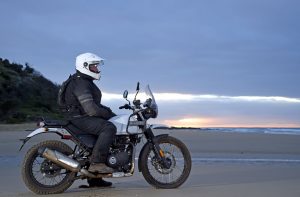
The Royal Enfield Himalayan is a bike with many positives, a few pointed flaws, and a great deal of fun to ride provided your expectations of it are balanced.
This is, after all, a $6,990 (ride-away) motorcycle with a carburettor – the Euro4 version with fuel-injection and ABS is on its way, but this is what we’re dealing with right now.
I spent two days belting it around fire-trails in the Otway ranges and skimming along the dampish bitumen of the Great Ocean Road. At the end of that time, I came to understand $6990 buys a brand-new 2017 motorcycle that reminded me so much of a 70s XL 250 Honda I felt I should have been riding it in my school uniform.
Anyone used to modern Adventure bikes will look with puzzlement at the Himalayan’s numbers. Does 24.5 horses and 32 Nm on a bike that weighs 182kgs have any business calling itself an “Adventure” bike?
Of course it does. Check your wealthy western privilege, pilgrim.
I come from a time when your bike was the only bike you had and you rode it everywhere you wanted to go, and because you did that, you were always having an ‘Adventure’ of some kind.
The Himalayan is a little more purpose-built for dirt than say my old GSX100EX, and while its benign simplicity and utter lack of “Prepare to die” power will not endear it to hard-core (or even medium-core) riders, I can certainly see how it would appeal to people for whom adventure means being able to cruise down a fire-trail at 40km/h, marvelling at the height of the trees, the freshness of the air, and the inherent beautness of nature.
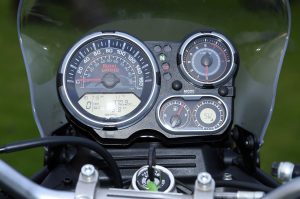 On the road, I managed to see an indicated 140km/h on the dial. It took me some time to get there and any hills would see the speedo needle dropping as I earnestly, but vainly, worked my way down the five-speed box looking for more grunt. And while the ergos were good, the seat was too hard for anything other than short road stints. Spend an hour belting up a freeway on a Himalayan and you will be thankful it does have proper stand-up ergonomics.
On the road, I managed to see an indicated 140km/h on the dial. It took me some time to get there and any hills would see the speedo needle dropping as I earnestly, but vainly, worked my way down the five-speed box looking for more grunt. And while the ergos were good, the seat was too hard for anything other than short road stints. Spend an hour belting up a freeway on a Himalayan and you will be thankful it does have proper stand-up ergonomics.
The brakes were also less than ideal. They felt wooden and while they did work, they didn’t seem to be all that keen to be used very hard. Or maybe that was just me and my relatively recent expectations of ABS systems. Still, it’s not like the Himalayan is going to be ridden in situations where massive braking is going to be needed. I’m sure the next version with the ABS will be better.
The tyres, CEAT units (I had never heard of them before, but it is a big Indian company that makes rubber for everything from tractors to bikes) meant to operate as dual-purpose jobbies, proved to be quite good on the road and probably less than superb on the dirt. They were fine when the trails were smooth, but problematical when people like Steve Martin essayed gnarly creek crossings and steep slippery riverbanks with them.
But the Himalayan does tick the boxes its main market in India is keen on.
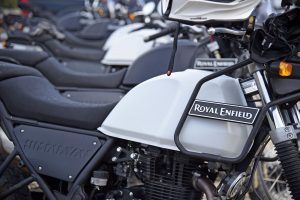 Fuel economy is very good (just under four litres for every 100km), and with 15-litres in the tank, you can space your petrol station visits out.
Fuel economy is very good (just under four litres for every 100km), and with 15-litres in the tank, you can space your petrol station visits out.
The 800mm seat height is also relatively low for a bike with dirt pretensions, and while normal-sized folks won’t have an issue, I did notice one of the shorter droogs on the launch struggle with such complexities as turning the bike around on the dirt, and promptly relegated those onerous duties to other people. Which was kinda cute.
Still, we cannot lose sight of what the core purpose of the Himalayan is.
It certainly isn’t to provide Toby Price with a viable alternative to his Dakar bike, despite its 21-inch front wheel.
There’s decent travel in the non-adjustable 41mm forks (200mm) and the linkage-equipped monoshock (180mm), but it’s not the kind of suspension you’ll be doing Hard Enduro on.
But that long-stroke 411cc motor is pretty smooth thanks to a balance shaft Royal Enfield has fitted for the very first time to one of its bikes. It’s not butter-on-glass smooth, but I understand it’s not the jackhammer fest of impending destruction the rest of the models serve up. I guess that’s what happens when a factory decides to build a new bike from the ground up rather than using the parts bin to build a “new’ model.
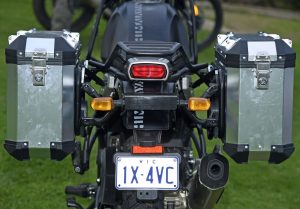 And the Himalayan is all new. The factory felt there was a place in the market for…well, I guess a less intimidating Adventure bike, and set out to build one with exactly this mind-set.
And the Himalayan is all new. The factory felt there was a place in the market for…well, I guess a less intimidating Adventure bike, and set out to build one with exactly this mind-set.
I reckon it’s worked.
The Himalayan is certainly not intimidating in any way. Not even in the looks department. It is not a pretty bike, but it certainly does look like it means business with the pipework arcing backwards off the front-end and cradling its tank. You’re meant to hang small bags off this exo-frame, which you can get as aftermarket bits from Royal Enfield, but I reckon it would look great with goat-bladders full of fermented yak-milk bulging off the sides. I do note these are not crash-bars per se. So don’t crash it and hope the mild-steel piping will save your tank.
The dash, with its analogue clocks and LCD accoutrements, is comprehensive and even offers you a compass, which I thought was pretty cool. A man always needs to know which way North lies.
The standard of finish is what one might expect from a sub-seven grand bike. You’ll see surface rust appear on bolts, but as a general observation, the bike seems to be better-made than others models in the Royal Enfield range. I cannot speak to its long-term robustness any more than I can speak to any other new bike’s long-term reliability. I only rode the Himalayan for two days. All I have to go on in terms of reliability are warranty claims and road-side assistance stats – and they are not easy to come by since the bike is brand new and yet to make its bones, as it were.
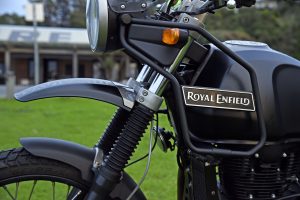 Only one of the press launch Himalayans failed to proceed, but that happens on the odd bike launch, so it’s not really an indication of anything other than shit happening.
Only one of the press launch Himalayans failed to proceed, but that happens on the odd bike launch, so it’s not really an indication of anything other than shit happening.
To be honest, and given what some of the riders put the bikes through, the Himalayans acquitted themselves quite well.
Royal Enfield is trying very hard with the Himalayan.
Which means riders (even LAM lambs) wanting to explore the Adventure market at a very low entry price don’t have to try very hard.
The Himalayan’s benign and gentle nature, its ability to just chug along at tender speeds on benevolent trails, while coping competently with paved roads, speaks volumes.
I was surprised at how much fun it was to ride. Here was a bike whose neck could be wrung without imperilling your own vertebrae.
It makes no demands on you, and provided you don’t make any unseemly demands on it, there won’t be any tears before bedtime.
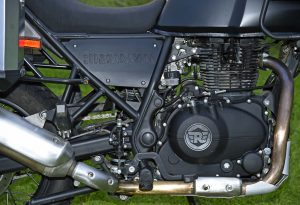 I feel Royal Enfield has indeed attained the goal it set for itself with the Himalayan. It is a simple bike, cloaked in $6990 honesty, much like the old XL250 it constantly reminded me of. It is very much a non-complicated bike looking to make a place for itself in an increasingly complex world. There’s nothing flash or high-tech about it – a fact which will appeal to many people, but which will still have detractors who crave cutting-edge technology on their bikes.
I feel Royal Enfield has indeed attained the goal it set for itself with the Himalayan. It is a simple bike, cloaked in $6990 honesty, much like the old XL250 it constantly reminded me of. It is very much a non-complicated bike looking to make a place for itself in an increasingly complex world. There’s nothing flash or high-tech about it – a fact which will appeal to many people, but which will still have detractors who crave cutting-edge technology on their bikes.
I didn’t love it, but I did like it. It’s quirky and kinda competent, and while it will never replace or compete with its German or Japanese counterparts, it’s just not meant to.
And seeing as it looks the business, the lies you tell your mates about your adventures will probably be believed.
Ultimately, if I was being pursued through the Hindu Kush by wild tribesmen with knives gripped in their teeth, I wouldn’t be too fussed about not having a three-level traction-control system. I’d be more concerned with where I could get more kerosene, while I re-jet my carby with an old rifle cartridge and re-stock my fermented yak-milk supplies.
I guess adventure has many interpretations.
The Himalayan is Royal Enfield’s.
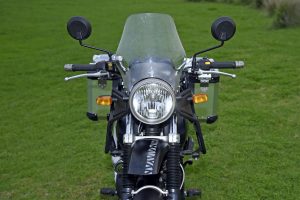
TECHNICAL THINGS
Air-cooled, four-stroke SOHC, two-valve single
Capacity: 411cc
Bore x stroke: 78 mm x 86 mm
Compression ratio: 9.5:1
Fuelling: Carburettor
Claimed maximum power: 24.5hp (18kW) at 6500rpm
Claimed maximum torque: 32Nm at 4250rpm
Type: Five-speed
Final drive: Chain
Clutch: Wet, multiplate
Frame: Split cradle frame
Front suspension: 41mm non-adjustable forks, 200mm travel
Rear suspension: Monoshock with linkage, 180mm travel
Front brakes: 300mm disc, twin-piston caliper
Rear brake: 240mm disc, single-piston caliper
Tyres: CEAT Gripp, 90/90-21 front, 120/90-17 rear
Claimed wet weight: 182kg
Seat height: 800mm
Wheelbase: 1465mm
Fuel capacity: 15 litres
Claimed fuel consumption: 3.5lt/100km
How much?
$6990 ride away
What colours does it come in?
White or gray.
Warranty
24 months, 20,000km
Words by Boris Mihailovic
